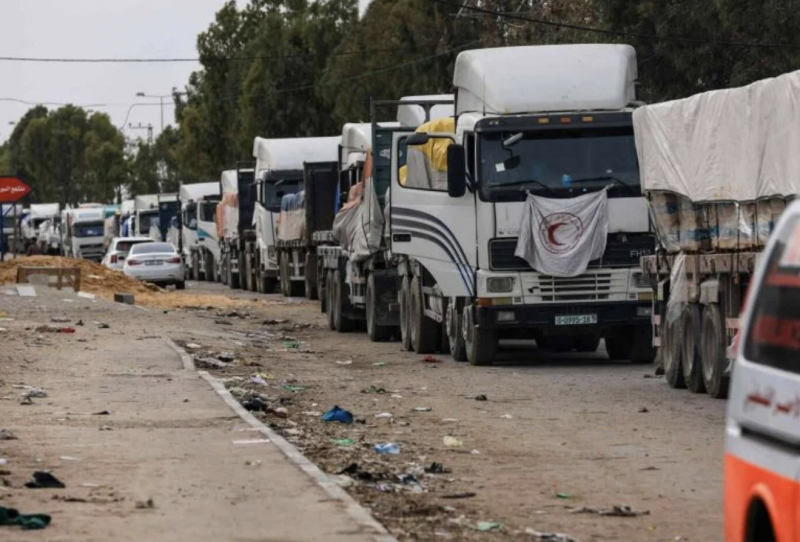
A large convoy of humanitarian aid arrived in Gaza City on Saturday, Nov. 25. (Credit: Mahmoud Hams/AFP)
It was a “massacre.”
On Feb. 29 at dawn, as nearly 30 food lorries arrived at an Israeli checkpoint in Gaza City, Israeli tanks fired at hundreds of Gazans gathered on al-Rashid Street to find food, said local officials and eye-witnesses.
The Gaza health authorities spoke of a gruesome death toll. Over 100 people were killed and 700 wounded, while ambiguity prevails over the presence of the Israeli army on the fringe of the convoy.
What was special about the Feb. 29 convoy?
Only a handful of humanitarian aid trucks approved by Israel arrived in the north of Gaza. Israeli officials, Palestinian businessmen and Western diplomats told the New York Times that Thursday’s aid convoy to Gaza City was “organized by Israel itself as part of a newly hatched partnership with local Palestinian businessmen.” It was the fourth convoy that Israel has authorized since Feb. 20.
According to the New York Times, Israeli security forces were supposed to escort and ensure the private convoy’s safety, as lootings have been reported in northern Gaza. In the drone video footage released by the Israeli army, two tanks are visible on a lane parallel to the aid trucks, to which a population that is one step from famine rushed. The crowd undoubtedly had access to the delivery notice the Gaza entrepreneurs posted on Facebook.
According to Israeli army spokesman Daniel Hagari, the troops opened fire on people who approached the trucks “in a manner that endangered them,” and “most of the people died in a stampede.” This version was refuted by eyewitnesses and the staff at Kamal Adwan Hospital, which reported that 95 percent of the injuries were from gunshots.
Why is it so hard to access northern Gaza?
The Israeli army practically controls the north of the enclave and has even established a corridor cutting the strip of land in two to facilitate its military operations and to control the passage between the north and the south.
“Since Dec. 29, half of UNRWA’s aid mission requests to northern Gaza have been rejected by the Israeli authorities. The last time UNRWA was authorized to deliver food aid to northern Gaza was on Jan. 23,” said UNRWA Director of Communications Juliette Touma.
In late January, Israel accused some UNRWA employees of taking part in the Oct. 7, 2023 Hamas attack, which resulted in many countries suspending their funding.
“Several attacks by the Israeli army on our convoys also endangered our teams, forcing us to stop our missions,” said Touma, referring to the Israeli army firing at an aid convoy on its way out of northern Gaza on Dec. 29, although it took the route designated by the army.
On Feb. 20, the World Food Program (WFP) said it is suspending aid deliveries to northern Gaza, due to lootings and violence against drivers, “until conditions are in place that allow for safe distributions.” Aid delivery resumed two days ago.
No crossing linking the north of Gaza to Israel is currently open, and the only border crossings operating at the moment are in Rafah, which borders Egypt, and Kerem Shalom, in the south.
According to the al-Majalla media outlet, the Israeli army is working with logistics companies to reopen the Karni crossing, located further north and closed since 2011, to allow aid. In the meantime, the Israeli army is limiting the routes that allow aid into Gaza.
What is the process for getting aid into Gaza?
Tel Aviv required the presence of the Israeli army at the various border crossings to check the shipments and filter out any smuggling of arms or other contraband. This thorough inspection partly explains the decline in the number of humanitarian aid convoys that entered the enclave.
From Feb. 1 to Feb. 27, an average of 96 trucks a day entered the Gaza Strip. UNRWA noted a 30 percent drop compared with January’s figures, and the lowest monthly average since November’s ceasefire, when Israel undertook to allow 200 trucks a day into the enclave.
Once they enter southern Gaza, the Gaza civil police are usually responsible for ensuring the safe transport of the shipments until they arrive at the humanitarian organizations’ warehouses, before being distributed independently by their teams. Since early February, the Gaza police have officially withdrawn and are no longer involved in protecting humanitarian convoys.
This decision followed an attack that targeted a vehicle, which killed six policemen on Feb. 6, as they were securing the passage of flour trucks, according to witnesses quoted by AFP.
Targeted and killed on several occasions, the Gazan police are accused by Israel of serving Hamas’ interests. “The IDF is working to dismantle Hamas’ military capabilities. Elements [of the police] involved in military activities could therefore be targeted,” said the Israeli army.
The Financial Times reported that two Western officials who had just returned from Gaza said that the Israeli refusal to allow Palestinian police officers to return to duty, although they are distinct from Hamas, is the biggest problem facing the delivery of humanitarian aid. An agreement brokered by Cairo, which would authorize the police to resume work without uniforms or sidearms, has yet to be concluded.
This article was originally published in L'Orient-Le Jour. Translated by Joelle El Khoury.